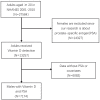Possible non-linear relation between prostate specific antigen and vitamin D: a machine learning study based on cross-section data
- PMID: 38817878
- PMCID: PMC11134423
- DOI: 10.7150/jca.96052
Possible non-linear relation between prostate specific antigen and vitamin D: a machine learning study based on cross-section data
Abstract
Objective: Due to inconsistent results in earlier investigations regarding the relationship between vitamin D and prostate-specific antigen (PSA), this study was conducted to gain a deeper understanding of the association between vitamin D and PSA. Methods: A total of 7174 male samples with 25(OH)D, PSA, and other variables were obtained from the National Health and Nutrition Examination Survey (NHANES) database. Three models, created through stepwise logistic regression, were employed to examine the dose-response association between PSA and 25(OH)D. Subsequently, restricted cubic spline analysis (RCS) was used to explore the nonlinear association between 25(OH)D and PSA. The study also compared the performance of four machine learning models in predicting PSA levels. Results: The dose-response relationship indicated a negative impact of high 25(OH)D levels on PSA (p for trend 0.05). The odds ratio (OR) of Q4 (7.73 with 95% CI (0.26, 15.76)) was significantly higher than Q1 (6.23 with 95% CI (0.24, 12.57)). OR values in Q2 and Q3 were less than 1 (Q2= 0.57 with 95% CI (-6.37, 8.04) and Q3= 0.26 with 95% CI (-5.94, 6.86)), suggesting a potential protective effect of 25(OH)D on PSA. RCS analysis revealed a U-shaped relationship between blood 25(OH)D levels and PSA, with serum 25(OH)D in the range of 20-134 ng/ml showing a potential decrease in PSA levels. Above this range, an increase in 25(OH)D might elevate PSA levels. Age (2.67 with 95% CI 2.24 to 3.1) and BMI (17.52 with 95% CI 7.65 to 26.32), along with the OR of obesity (10.36 with 95% CI 0.68 to 20.18), were identified as potential PSA risk factors. Among the machine learning models, the random forest algorithm performed the best in predicting PSA levels. Conclusion: This study revealed a U-shaped relationship between 25(OH)D and PSA, with PSA potentially declining when 25(OH)D is between 20 and 134 ng/mL and possibly rising above this range. The random forest method proved effective in both predicting PSA levels and guiding vitamin D dosage.
Keywords: 25(OH)D; NHANES.; Vitamin D; prostate cancer; prostate specific antigen.
© The author(s).
Conflict of interest statement
Competing Interests: The authors have declared that no competing interest exists.
Figures




Similar articles
-
25(OH) vitamin D and functional outcomes in older adults admitted to rehabilitation units: the safari study.Osteoporos Int. 2019 Apr;30(4):887-895. doi: 10.1007/s00198-019-04845-7. Epub 2019 Jan 16. Osteoporos Int. 2019. PMID: 30652217
-
Association between urinary metals and prostate-specific antigen in aging population with depression: a cross-sectional study.Front Public Health. 2024 May 23;12:1401072. doi: 10.3389/fpubh.2024.1401072. eCollection 2024. Front Public Health. 2024. PMID: 38846601 Free PMC article.
-
Association between Serum 25-Hydroxyvitamin D and Abdominal Aortic Calcification: A Large Cross-Sectional Study.Int J Clin Pract. 2023 Feb 13;2023:1621873. doi: 10.1155/2023/1621873. eCollection 2023. Int J Clin Pract. 2023. PMID: 36815008 Free PMC article.
-
Vitamin D and Calcium: A Systematic Review of Health Outcomes (Update).Evid Rep Technol Assess (Full Rep). 2014 Sep;(217):1-929. doi: 10.23970/AHRQEPCERTA217. Evid Rep Technol Assess (Full Rep). 2014. PMID: 30313003
-
Plasma vitamin D levels, menopause, and risk of breast cancer: dose-response meta-analysis of prospective studies.Medicine (Baltimore). 2013 May;92(3):123-131. doi: 10.1097/MD.0b013e3182943bc2. Medicine (Baltimore). 2013. PMID: 23625163 Free PMC article. Review.
Cited by
-
Exploration in association between vitamin D, sleep quality, and osteoarthritis: A modeling study.Medicine (Baltimore). 2024 Oct 4;103(40):e40021. doi: 10.1097/MD.0000000000040021. Medicine (Baltimore). 2024. PMID: 39465703 Free PMC article.
-
Relationship between BMI, indicators of lipid metabolism and diabetic neuropathy: a Mendelian randomization study.Diabetol Metab Syndr. 2025 Jan 3;17(1):1. doi: 10.1186/s13098-024-01543-1. Diabetol Metab Syndr. 2025. PMID: 39754202 Free PMC article.
-
Association of volatile organic compounds with bone mineral density and osteoporosis: a cross-sectional study.BMC Musculoskelet Disord. 2025 Sep 1;26(1):835. doi: 10.1186/s12891-025-09093-x. BMC Musculoskelet Disord. 2025. PMID: 40890666 Free PMC article.
-
The association between triglyceride glucose index and suicidal ideation in American adults: Results from NHANES 2005 to 2018.Medicine (Baltimore). 2024 Oct 11;103(41):e40011. doi: 10.1097/MD.0000000000040011. Medicine (Baltimore). 2024. PMID: 39465876 Free PMC article.
-
Global, regional and country-specific burden of patella, tibia or fibula, or ankle fractures and its prediction to 2035: findings from global burden of disease study 2019.BMC Public Health. 2024 Nov 14;24(1):3162. doi: 10.1186/s12889-024-20675-7. BMC Public Health. 2024. PMID: 39543488 Free PMC article.
References
-
- Kanaan Y, Copeland RL. The link between vitamin D and prostate cancer. Nat Rev Cancer. 2022;22(8):435. - PubMed
-
- Zhao XY, Feldman D. The role of vitamin D in prostate cancer. Steroids. 2001;66(3-5):293–300. - PubMed
-
- Maksymchuk OV, Kashuba VI. Altered expression of cytochrome P450 enzymes involved in metabolism of androgens and vitamin D in the prostate as a risk factor for prostate cancer. Pharmacol Rep. 2020;72(5):1161–72. - PubMed
-
- Thederan I, Chandrasekar T, Tennstedt P, Knipper S, Kuehl L, Tilki D. et al. Circulating vitamin d and selenium levels and outcome in prostate cancer patients: Lessons from the MARTINI-Lifestyle cohort. Eur Urol Focus. 2021;7(5):973–79. - PubMed
LinkOut - more resources
Full Text Sources
Research Materials
Miscellaneous

